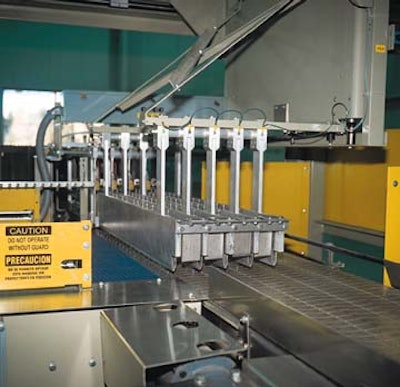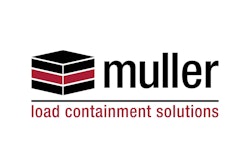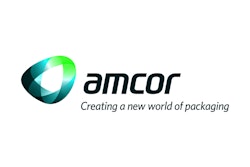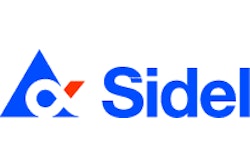Perched above a huge underground aquifer that holds some of Canada’s finest natural water, Aberfoyle Springs has sold a lot of bottled water over the past five years. Plant manager Mike Eccles sums it up this way.
“If you compare the volume we did five years ago to what we did in ’99, our growth has been nothing short of phenomenal.”
Volumes like Aberfoyle’s make self-manufacturing of bottles a natural fit, and Aberfoyle is aggressively enlarging its blow-molding capabilities. Its first Sidel (Norcross, GA) SBO-20 reheat-and-blow system was installed in April, and a duplicate was being uncrated when Packaging World visited Aberfoyle’s Guelph, Ontario, headquarters plant in October.
“When this new system is up and running, we’ll be able to make 60 percent of the half-liter bottles we need,” says Eccles. “There’s a significant cost savings when you don’t have your bottles made for you.”
He admits that entering the bottle-making business when your core business has always been beverage filling is “a pretty big leap” from a technology and personnel standpoint. But Aberfoyle made the leap painlessly enough. As for talent, it was primarily home-grown.
“We looked for people with blow-molding experience, but we weren’t very successful, so we wound up training our own,” says Eccles. “Sidel helped a lot, both for operating and maintenance people.”
Cost savings hasn’t been the only benefit gained by bringing blow molding in-house, says Eccles. “In addition to the advantage of being more self-reliant, self-manufacturing has made it easier for us to have our own custom mold. We run a 17.2-gram preform with a 30 ?-mm diameter and a three-start finish.”
By “three-start finish,” Eccles is referring to the threading design. Three separate thread structures, each designed on an inclined plane, engage with corresponding threads on the Bericap (Burlington, Ontario, Canada) injection-molded polypropylene closure. “One-third of a revolution opens or closes the bottle,” says Eccles. Not only does that mean easier removal and reclosure by the consumer, it also means less threading compared to a continuous-thread closure. “That means less plastic and a lighter bottle,” observes Eccles. The preforms now used by Aberfoyle are provided by Amcor PET Packaging (Mississauga, Ontario, Canada).
Doing the wave
Another bit of customizing since self-manufacture began is a distinctive wave pattern in the bottle sidewall. This is consistent with a key graphic image used throughout Aberfoyle’s trade dress and promotional material.
The Sidel system now running at Aberfoyle produces about 470 bottles/min. Running two 11-hr shifts, the company makes 630ꯠ bottles a day “on a good day,” says Eccles. Only three people are required: one at the blow molder, one at the palletizer and one operating a forklift.
The operator at the blow molder is responsible for loading preforms into a floor-level hopper. An elevator takes the preforms up to an orienter, and then the preforms are fed down a chute into the blow molder for heating, conditioning and stretch blow molding.
Emerging from the blow molder, bottles move to a palletizing station by way of a 180’ Rafale air conveyor system from Gebo (Bradenton, FL). Rather than proceeding directly to the palletizer, this conveyor loops back once in the direction of the blow molder to provide accumulation time in case a downstream operation—palletizing, banding or stretch wrapping—goes down.
“I’m a big believer in accumulation,” says Eccles. “As long as the blow molder continues running, we make money.”
Just ahead of the palletizer, air conveying of bottles gives way to tabletop conveying and a multicomponent palletizing system supplied by Ouellette (Fenton, MO). First, a diverter fans the bottles out from single-file orientation into four separate lanes. A programmable logic controller governs the diverter based on inputs from photocells in each lane. If a lane is in need of bottles, the photocells communicate that information to the PLC, which then sends bottles in that direction.
Forming rows
Bottles move next through a rounded-off turn and into a row-former that sweeps back and forth in a direction perpendicular to the direction in which the bottles enter on their tabletop conveyor. The row-former sweeps rows of bottles onto a matte-top conveyor leading toward the palletizer. Each pallet layer holds 17 rows of bottles, so the row-former sweeps four rows four times and then a single row the fifth time for each pallet layer.
When 17 rows are in place on the matte-top conveyor, a gate lifts and the entire layer moves forward. Another gate holds the bottles momentarily while a slip sheet is automatically placed on top. With the slipsheet in place, the layer is released, moving to a layer-transfer device. Here, a square frame closes in from all four sides to gently secure all the bottles into a nice, tight formation. The layer is then advanced to a transfer plate that rises to the appropriate level so the layer can be pushed onto the slipsheet.
When 11 layers are on the pallet, a top cap is applied by the attending operator, and a powered roller conveyor moves the pallet out of the Ouellette system and into a Signode (Glenview, IL) bander that applies four plastic bands to keep the bottles steady. Then the pallet moves into an ITW Muller (Glenview, IL) Octopus stretch wrapper whose film carriage moves around the stationary pallet until wrapping is complete. The stretch wrap used is a 50-ga linear low-density polyethylene.
“You have to be pretty careful wrapping a light container like this, because if you wrap it too tightly the bottles will take on an oval shape,” says Eccles. “The Muller machine has great control, so you can secure the integrity of the load without putting too much pressure on it.”
With the second Sidel blow molder will come new palletizing and banding systems identical to the ones now in operation. This will bring a repositioning of the Muller stretch wrapper.
“We’ll move the stretch wrapper between the two Signode banders,” says Eccles. “The wrapper can handle 30-some loads per hour, so we can easily feed two blow-molding lines into it.”
After stretch wrapping, all that remains is removal of the pallet to a warehouse area. From there it goes to the filling line when it’s needed, typically in a few days.
Eccles recognizes the irony in building, banding and wrapping a pallet load only to tear it all apart a few days later in a filling room that’s right around the corner. But the alternative (in-line blowing and filling) is not his cup of tea.
“Maybe I’m old-fashioned, but I view blowing and filling as two separate businesses, even though many in the industry are beginning to view them as a single operation,” says Eccles. Having said that, however, he quickly acknowledges that in-line blow/fill systems are inevitable. In fact, as soon as he can be convinced that such systems can run reliably at 95% efficiency, he says he’ll no doubt begin looking into the concept.
In the meantime, Eccles is busy getting Aberfoyle’s second SBO-20 machine up and running. He probably shouldn’t waste much time, either. “We have plans for a third Sidel system in 2000,” he says.





























